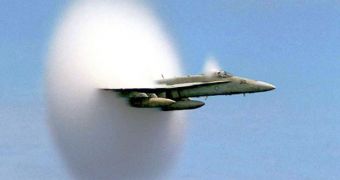The problem with supersonic aircrafts today is that when they surpass the speed of sound they create a so-called sonic boom, an acoustic phenomenon similar to the one generated by a relatively large detonation. It is just a sound, but it packs a mighty punch. Just imagine hearing a sudden explosion in the middle of the night, while you're sleeping, as a jet goes to supersonic speed over your house. Most of the time, such events never happen because flight paths ensure that the sonic booms never occur over populated areas, but it now seems that the sonic boom could be abolished, or at least partially.
Sound travels through the air at a temperature of 21.1 degrees Celsius with a speed of 1232 kilometers per second, or 344 meters per second. When the aircraft exceeds this speed it is in fact traveling faster than the sound it generates, forcing the sound to travel faster than it is capable of. The speed of sound is called Mach 1, where '1' is the multiplier for the speed of sound - therefore Mach 2 is twice the speed of sound.
When the speed of sound is exceeded, the sound waves traveling along with the aircraft are compressed towards its end in a shock wave called a compressional heat shock, creating a rarefractional tail shock that then follows a rapid expansion that manifests itself through a powerful acoustic sound that we call sonic boom. The sound is generated as long as the aircraft travels as supersonic speeds.
Not only that such sounds produce acoustic pollution, but they may also generate mechanical malfunctions. The Concorde for example, world's first commercial supersonic vehicle, remained into service until this year and was capable of exceeding Mach 2, but its flight paths rarely took it over populated areas when the sonic boom occurred.
The problem of the sonic boom is now being tackled by NASA and JAXA, who began a collaboration to model the phenomenon. The sonic boom will probably never be entirely resolved, but it can be diminished so that the acoustic and mechanical effects are reduced to a minimum. By doing so, Mach capable aircrafts could be developed to operate between Japan and the US. JAXA is already running a program called Silent Supersonic Technology Demonstration that has in plan the reduction of sonic boom acoustic intensities by at least 50 percent.

 14 DAY TRIAL //
14 DAY TRIAL //